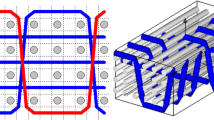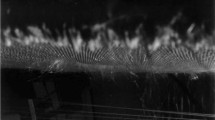Abstract
The purpose of this study is to analyse the influence of weaving parameters of 3D warp interlock fabrics on their mechanical properties. Using the same yarns in the warp and weft direction, four main product and process parameters have been chosen as the weave diagram, the weft density and positions of stuffer and linking warp yarns inside the woven structure. Based on several 3D warp interlock architecture produced on the same dobby loom, the mechanical characterization of these fabrics have been performed by unidirectional tensile and bending tests, both in the warp and weft directions. Thanks to this complete protocol; a comparison between 3D warp interlock woven architectures has been done to reveal the influence of process and product parameters on their mechanical performances.
Access this chapter
Tax calculation will be finalised at checkout
Purchases are for personal use only
Similar content being viewed by others
References
Nauman, S. (2008). Modélisation Géométrique de tissu 3D Interlock. Roubaix, France, Master report: Laboratoire GEMTEX.
Nauman, S. (2011). Geometrical modelling and characterization of 3D warp interlock composites and their on-line structural health monitoring using flexible textile sensors, University of Lille 1, Lille, Ph-D thesis. http://www.theses.fr/en/2011LIL10010, 24/03/2011.
Lapeyronnie, P. (2010). Mise en œuvre et comportement mécanique de composites organiques renforcés de structures 3D interlocks. Université de Lille 1, Douai, France, Thèse de doctorat http://www.theses.fr/en/2010LIL10126, 14/12/2010.
Ha-Minh, C. (2011). Comportement mécanique des matériaux tissés soumis à un impact balistique: approches expérimentale, numérique et analytique. Université de Lille 1, Lille, France, Thèse de doctorat http://www.theses.fr/en/2011LIL10184, 17/11/2011.
Lefebvre, M. (2011). Résistance à l’impact balistique de matériaux composites à renforts Interlocks tissés. Application au blindage de véhicules. Université de Valenciennes, Valenciennes, Thèse de doctorat http://www.theses.fr/en/2011VALE0030, 07/12/2011.
Provost, B. (2013). Étude et Réalisation d’une solution à renfort tissé interlock pour la protection balistique de véhicule. Université de Valenciennes, Valenciennes, Thèse de doctorat http://www.theses.fr/en/2013VALE0003, 14/01/2013.
Cristian, I., Boussu, F., & Nauman, S. (2010). Interesting parameters of 3D warp interlock fabrics influencing the mechanical properties of the final composite structures. In 10th World textile conference, Vilnius, Lithuania, 21–23 June, 2010.
Tong, L., Mouritz, A. P., & Bannister, M. K. (2002). 3D fibre reinforced composite materials. London: Elsevier Applied Science. ISBN 978-0-08-043938-9.
Hu, J. (2008). 3D fibrous assemblies, properties applications and modelling of three dimensional textile structure. Woodhead Publishing, vol. 74. ISBN-978-1-84569-377-0.
Sheng, S. Z., & Hoa, S. V. (2003). Modelling of 3D angle interlock woven fabric composites. Journal of Thermoplastic Composite Materials, 16(1), 45–59. https://doi.org/10.1177/0892705703016001206.
Mouritz, A. P., Bannister, M. K., Falzon, P. J., & Leong, K. H. (1999). Review of applications for advanced three-dimensional fibre textile composites. Composites Part A Applied Science and Manufacturing, 30(12), 1445–1461. https://doi.org/10.1016/S1359-835X(99)00034-2.
Nauman, S., Boussu, F., Cristian, I., & Koncar, V. (2009). Impact of 3D woven structure onto the high performance yarn properties. In Second conference on intelligent textiles and mass customisation, textile composites workshop, Casablanca, Morocco, 12–14th November 2009.
Brandt, J., Drechsler, K., Arendts, F.J. (1996). Mechanical performance of composites based on various three dimensional woven fibre preforms. Composites Sciences and Technology, 56(3), 381–386. doi:10.1016/0266-3538(95)00135-2.
Lapeyronnie, P., Le Grognec, P., Binetruy, C., & Boussu, F. (2010). Angle-interlock reinforcements: Weaving and the mechanical properties of composites. JEC Composites, 58, 58–59.
Tan, P., Tong, L., & Steven, G. P. (1999). Micromechanics models for mechanical and thermomechanical properties of 3D through-the-thickness angle interlock woven composites. Composites: Part A, 30(5), 637–648. https://doi.org/10.1016/S1359-835X(98)00176-6.
Tsai, K. H., Chiu, C. H., & Wu, T. H. (2000). Fatigue behaviour of 3D multi-layer angle interlock woven composite plates. Composites Science and Technology, 60, 241–248. https://doi.org/10.1016/S0266-3538(99)00120-7.
Baucom, J.N., & Zikry, M.A. (2003). Evolution of failure mechanisms in 2D and 3D woven composite systems under quasi-static perforation. Journal of Composite Materials, 37(18), 651–1674, 01/01 2003. doi:10.1177/0021998303035178.
Tanzawa, Y., Watanabe, N., & Ishikawa, T. (1999). Interlaminar fracture toughness of 3-D orthogonal interlocked fabric composites. Composites Science and Technology, 59(8), 1261–1270. doi:10.1016/S0266-3538(98)00167-5.
Chen, F., & Hodgkinson, J.M. (2009). Impact behaviour of composites with different fibre architecture. Proceedings of the Institution of Mechanical Engineers, Part G: Journal of Aerospace Engineering, 223(7), 1009–1017, 01/11 2009.
Naik, N. K., Azad, S. K., Durga Prasad, N. M., & Thur, P. (2001). Stress and failure analysis of 3D orthogonal interlock woven composites. Journal of Reinforced Plastics and Composites, 20(17), 1485–1523. https://doi.org/10.1177/073168401772679110.
Padaki, N.V., Alagirusamy, R., Deopura, B.L., & Fangueiro, R. (2010). Influence of preform interlacement on the low velocity impact behavior of multilayer textile composites. Journal of Industrial Textiles, 40(2), 171–185, 26/05 2010. DOI:10.1177/1528083710366723.
Tung, P.S., & Jayaraman, S. (1991). Three dimensional multilayer woven preforms for composites. In High-tech fibrous materials. Washington, DC, Washington, USA: ACS Publisher, vol. 457, Chap. 4, pp. 53–80. DOI:10.1021/bk-1991-0457.ch004.
Coman, F., Herszberg, L., & Bannister, M. (1996). Design and analysis of 3D woven preforms for composite structures. Science and Engineering of Composite Materials, 5(2), 83–96.
Boussu, F., Cristian, I., & Nauman, S. (2015). General definition of 3D warp interlock fabric architecture. Composites: Part B, 81, 171–188. https://doi.org/10.1016/j.compositesb.2015.07.013.
Hu, J. (2008). 3D fibrous assemblies, properties applications and modelling of three dimensional textile structure. Woodhead Publishing, vol. 74.
Lomov, S., Gusakov, A. V., Huysmans, G., Prodromou, A., & Verpoest, I. (2000). Textile geometry preprocessor for meso-mechanical models of woven composites. Composites Science and Technology, 60, 2083–2095.
Author information
Authors and Affiliations
Corresponding author
Editor information
Editors and Affiliations
Rights and permissions
Copyright information
© 2018 Springer International Publishing AG
About this chapter
Cite this chapter
Boussu, F., Picard, S., Soulat, D. (2018). Interesting Mechanical Properties of 3D Warp Interlock Fabrics. In: Kyosev, Y., Mahltig, B., Schwarz-Pfeiffer, A. (eds) Narrow and Smart Textiles. Springer, Cham. https://doi.org/10.1007/978-3-319-69050-6_3
Download citation
DOI: https://doi.org/10.1007/978-3-319-69050-6_3
Published:
Publisher Name: Springer, Cham
Print ISBN: 978-3-319-69049-0
Online ISBN: 978-3-319-69050-6
eBook Packages: Chemistry and Materials ScienceChemistry and Material Science (R0)




